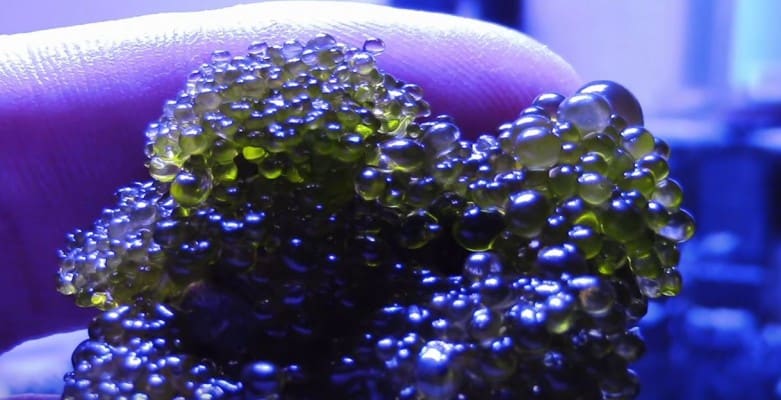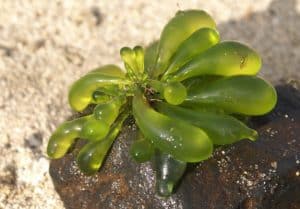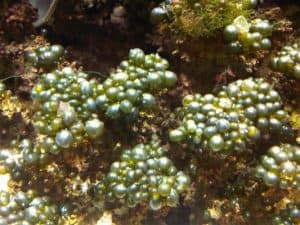Bubble Algae might look innocent and amazing to you at the beginning. You might even leave those alone on the new live rock. But, when they grow rapidly and take control of your reef tank, you have to be cruel to them for the sake of being kind to the other creatures of the tank.
There are various effective ways to get rid of bubble algae. Manual removal, introducing bubble algae-eating crews, denial of nutrients are some of the proven ways many aquarists try to remove bubble algae from their reef tank.
In this article, I am going to discuss the types and origin of bubble algae in the reef tank in the first part. The next part will cover the ways on how to get rid of bubble algae in a reef tank. Just keep reading.
What Are Bubble Algae?
Bubble algae are nuisance algae that have their origin in tropical and subtropical oceans around the world. They are also called ‘sailor’s eyeballs’ and ‘sea pearl’ due to their shape and color. They thrive easily on saltwater and reef tanks in a favorable atmosphere.
Bubble algae are unicellular with elongated or spherical thalli or thallus full of fluids. Usually, they are green. But, some of the species can be light green, emerald, dark, pale, and even red.
There are a variety of bubble algae but with apparently similar features. All of them share a bubble-like structure, presence of small roots, absence of any stems, and reproduction using the spores.
Multiple nuclei and chloroplasts in the cell of bubble algae let them thrive by performing photosynthesis both in the reef tank or in their natural habitat. They can grow either individually or in clusters. They grow pretty rapidly by cell division.

Common Types of Bubble Algae in Reef Tank
If you think that there are only green bubble algae are the only species that affect the reef tank, you are not right. There are many types of bubble algae with their distinguished features with different sizes and shapes. Here are some of the most common bubble algae species:
Ventricaria ventricosa:
It is the most common variety of bubble algae found in reef aquariums. At first, it was called Valonia ventricosa, and later it was renamed to the present name. This species of bubble algae has a rounded single thallus filled by fluids.
It differs from other bubble algae in the sense that it comes in a single form without having any daughter vesicles. It can survive in low lights and herbivores do not find it desirable.
Boergesenia forbesii:

This species of bubble algae features elongated bladders of 1 inch in width and 2 inches in length. All the bladders of this bubble algae have a connection with a single root structure.
With less hardy cell walls than ventricosa, Boergesenia forbesii can grow easily on coral, sponges, and even other algae. They thrive unbranched and in small clusters.
Valonia aegagropila:
This species of bubble algae features dark or olive-green small bladders. They form compact and densely packed clusters that make it tough to remove them manually.
Valonia utricularis:

Coming with slightly curved and elongated bladders, Valonia utricularis are interconnected in compact clusters. The vesicles of Valonia utricularis are quite delicate and prone to rupture easily, especially when you make an effort to remove them from the rock surface. They are usually half-inch in diameter and 2 inches in length.
Valonia macrophysa:
Valonia macrophysa species of bubble algae have many things in common with Valonia utricularis. It has dark green bladders of a single cell with a length of an inch and a thickness of half an inch. With slight distortion or swelling at the top end, this species features quite smaller vesicles.
Dictyosphaeria cavernosa:
This bubble algae with pitted-looking bubbles is pretty unusual. It creates irregular-shaped and unicellular kinds of bubbles in the aquarium. The thallus walls of Dictyosphaeria cavernosa are formed with miniature cells. When these bubble algae mature, the bladder ruptures automatically.
How Do Bubble Algae Get into the Reef Tank?
Hitchhiking on newly brought live rock is the #1 way for the bubble algae to get inside your reef aquarium. You cannot detect them at the beginning due to their tiny size. They just keep themselves attached to the rocks through small spores.
You can only notice them when they become full-fledged bubble algae with their real shape covering the rock and the substrate.
To keep your reef tank protected from the invasion of bubble algae, you should always quarantine the new live rocks as you do for the fish and invertebrate.
When it comes to bringing new coral specimens, check the attached plugs, disks, and rocks very closely to see if the bubble algae are using any of those parts to hitch a ride into the reef tank.
How to Get Rid of Bubble Algae in Reef Tank?
You might be believing that bubble algae will disappear on their own. But, most of the time, they are too stubborn to act as your expectation. Fortunately, there are a few ways to get rid of the bubble algae from your tank.
However, it might need time and effort, especially if they have stronger colonies in your reef tank. If your tank has a large number of bubble algae, you have to spend more time and might need to follow multiple ways to remove them.
Here are 3 effective ways to deal with the bubble algae in reef tank:
- Removal of the bubble algae manually
- Employing the natural predators in the reef tank, and
- Restricting the nutrients and resources.
Let me discuss them one by one.
1. Remove the Bubble Algae Manually
If you have caught the bubble algae at the very outset of their journey, it is best to remove them manually. Make use of your hands or a sharpened screwdriver (flathead) to remove the bubble algae vesicles attached to the rocks via roots. Avoid scrubbing the bubble algae by all means.
When you have dislodged the vesicle, the next step is to remove the vesicles from the aquarium. Cutting the top off and leaving the rest of the base inside the tank will bear no fruit as that can grow back.
You can also remove the bubble algae differently. Place the infested rock to a saltwater basin and then proceed to remove the bladders. Once you have removed the bladders, rinse the rock thoroughly with tank water and place that back inside the tank.
Remember, to avoid the spores flowing all over the tank, it is best to turn off all the powerheads and pumps while you are following the manual process.
2. Add Natural Bubble Algae Predators in the Reef Tank
Different kinds of invertebrates, fish, and urchins are effective natural predators for bubble algae.
Invertebrates: Many invertebrates such as Emerald green crab love to consume a variety of bubble algae species. But, as they are omnivorous, the corals and snails might get consumed as well.
Another problem of using the invertebrates is that when they tear up the bubble algae to eat the ruptured bladders can release algae cells into the tank water and pollute it. However, it’ll not be a big deal if you have installed a good filtration system in your reef tank.
Some other invertebrates that consume the bubble algae are as follows:
- Ercolania endophytophaga
- Turbo spp
- herbivorous snails
- Trochus spp
Fish: Certain fish species like Rabbitfish, Surgeonfish, Tangs, etc. can eat away the bubble algae of reef tanks. However, as these fishes may show territorial behavior, they are not perfect to be added in small reef tanks.
Urchins: If there exist no other algae apart from bubble algae, Diadema setosum eats away the small vesicles finding no other alternative. But, they are damaging to your corals.
3. Restrict the Nutrients and Resources in the Reef Tank
If you deny the nutrients required for the bubble algae to thrive, that’s another effective way to prevent the spread of the existing bubble algae.
You can think of adding ornamental algae such as Caulerpa or Chaetomorpha algae so that the bubble algae starve to death. Coralline algae along with Halimeda work to prevent the colonization of bubble algae by growing rapidly.
Denying the bubble algae the light and space resources can also help you in the fight against them.
What’s Wrong with the Bubble Algae?
You might love the shape of bubble algae and those might seem quite innocent to you. But are they as innocent as they look? Sorry to say, the answer is ‘no’.
Nothing can be more disastrous than getting distracted by their outer beauty and leaving them alone to thrive inside your reef tank.
I suggest you not be allured by the beautiful appearance or allow them to grow to such an extent that they obstruct coral growth and damage the water chemistry.
Yes, it is right that a few bubbles here and there are not very harmful to your reef tank. But, you keep them unchecked being too kind to them, they will make colonies of their own inside the tank. They will cover all the corals, rocks, and hard surfaces.
And even worse, if some of the bubbles just get loose from their clusters, they will easily clog the powerhead intakes, substrate vacuums, and overflow tubes. Thus, your dream of making a healthy reef will nip in the bud.
Once they create a bunch of clusters and colonies, it will be tough to eliminate them from the tank by adopting the manual removal process only.
Can Bubble Algae Harm Coral Growth?
Unfortunately, yes. Though bubble algae are not toxic or poisonous, they can have negative impacts on the growth of corals. They begin to grasp the corals from the edge at the beginning and keep on spreading to cover the entire coral including the stems.
After a certain period, you will find that the corals are not getting the proper nutrition and light to grow up as the bubble algae have covered them from all sides.
That’s why I recommend you remove the bubble algae as soon as possible from your reef tank. The quicker you can remove them, the better and healthier the reef system you will have.
Final Thoughts
Removing bubble algae becomes far easier if you take quick actions against them. If you give them time to thrive and cover the entire tank, you will find it hard to bring the natural order back.
Now that you know how to get rid of bubble algae in the reef tank, proceed on to test the ways I have mentioned above one by one.

